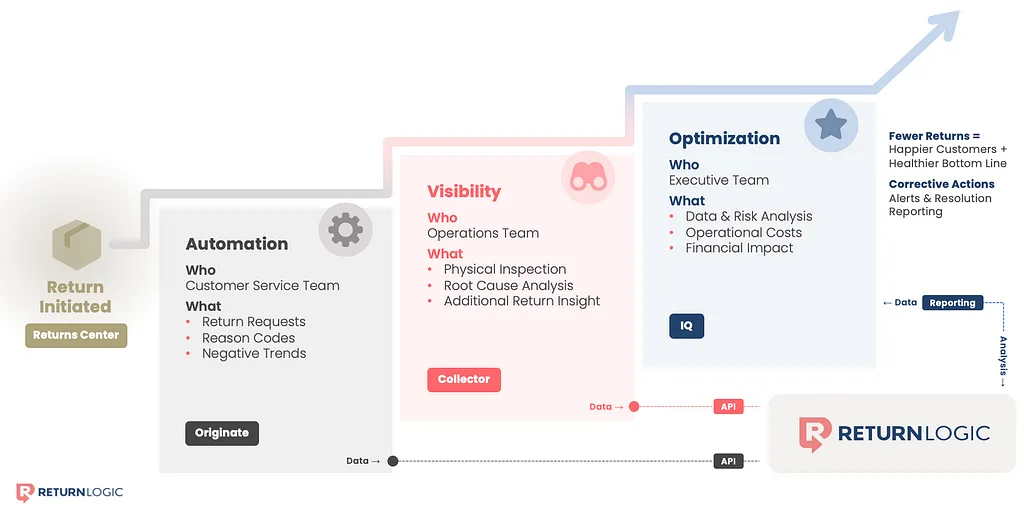Return Magic vs. ReturnLogic: When to Make the Switch

As you scale your Shopify store, returns get more difficult to manage. Each retailer has a natural progression, which we call the Returns Hierarchy of Needs. When ecommerce retailers first start out, they can probably get away with manually handling returned merchandise or using a simple app like Return Magic. However, as sales volumes increase, returns start to become harder to manage.
Why?
With an increase in sales, reverse logistics and reverse supply chains become more complicated and disconnected. A forward supply chain is straightforward (pun intended) with one destination, whereas reverse supply chains often have multiple touchpoints and systems needed. This leads to scattered data, customer frustration, and money slipping through the cracks.
Once retailers hit a returns volume of 100-150 per month, it’s beneficial for them to transition from a returns management app to a more robust returns management software.
But what exactly are the differences between a returns app and a returns software and when does a retailer know when to make the switch?
Let’s find out.
Returns Management Apps
There are over 6,000 publicly available Shopify apps – with the average merchant using about 6 apps to run their business. According to internal data, nearly 80% of Shopify merchants don’t have a returns app or software in place. However, for those who do, Return Magic was one of the original returns management apps and has been a great tool for retailers who handle under 100 returns per month. When retailers manage between 50-100 returns per month, a simplified automation app is usually enough for them to get by.
With returns apps like Return Magic, retailers can create a returns portal for shoppers, automate cash and gift card returns, auto generate shipping labels, and set up simple workflows.

Once retailers get between 100-150 returns per month, operations start to get more complicated, and visibility and the labor associated for managing returns becomes an issue. You might hear questions like these from your customer service support team:
- “How long is it taking us to close out customer tickets?”
- “Do we know how long it’s taking for shoppers to get their items or money back?”
- “Have you heard from the warehouse team about the disposition of that returned item?
Once retailers get over 150 returns per month, optimization starts to become a problem. You might hear questions like these from your ops team:
- “Should we do free return shipping?”
- “Do we know how often this item is getting returned?”
- “Is 30 days too short of a return window?”
If you’re struggling to answer these questions, it might be time to consider upgrading to a returns management software.
Returns Management Software
Returns management software have every feature a returns app has but are designed to help retailers scale their operations by automating and optimizing their product returns and reverse logistics processes. Returns management software exists to answer the questions listed in the previous section. For example, returns management software enable retailers to:
- Customize their Returns Portals beyond just adding a company logo
- Automate exchanges, store credit, refunds, warranties, or any other return type
- Provide customizable workflows
- Enforce Return policies
- Maximize rich data and strong reporting to uncover toxic products and marketing opportunities
- Support integrations and APIs to connect every tool in the reverse supply chain
And much more, depending on which returns management software you choose.
All in all, returns management software helps e-commerce retailers automate, gain visibility, and optimize product returns and operations to scale their business to the next level. With the power of returns data, retailers can not only reduce their return rate, but also drive key innovations in their processes and products. Being able to handle a return is nice but being able to know exactly why a return happened, how it impacts your business, and what you can do about it, is ultimately the fastest path to growth.
Conclusion
Return Magic was a great starting point for a lot of Shopify retailers looking to get a handle on returns. However, it was not designed to scale with growing e-commerce retailers. The need for an automated, connected, and optimized returns process is pivotal for growing brands and retailers – robust returns management software is essential to their success.
We’ve helped countless Return Magic users make the switch to ReturnLogic. Find out how with a personalized demo!





